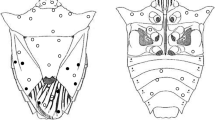Summary
Larvae of the ithomiine butterflyPlacidula euryanassa sequester tropane alkaloids (TAs) from the host plantBrugmansia suaveolens and pass them through the pupae to freshly emerged adults. Wild caught adults also show in their tissues, variable amounts of pyrrolidizine alkaloids (PAs), probably sequestered from variable plant sources and subject to dynamics of incorporation, accumulation and utilization of PAs by ithomiine butterflies. The ratio TAs/PAs is also variable between different populations.Miraleria cymothoe, another ithomiine that feeds onB. suaveolens as larvae, does not sequester TAs from the host-plant, but sequesters PAs from plant sources visited by the adult butterflies. The main alkaloid found in both butterflies is lycopsamine, which also is the principal PA found in all genera of Ithomiinae.
Similar content being viewed by others
References
Bingley JB (1968) Solvent and temperature effects in the determination of pyrrolizidine alkaloids with 4-dimethylaminobenzaldehyde. Anal Chem 40:1166–1167
Brown Jr KS (1984) Adult-obtained pyrrolizidine alkaloids defend ithomiine butterflies against a spider predator. Nature 307:707–709
Brown Jr KS (1985) Chemical ecology of dehydropyrrolizidine alkaloids in adult Ithomiinae (Lepidoptera: Nymphalidae). Rev bras Biol 44:435–460.
Brown Jr KS (1987) Chemistry at the Solanaceae/Ithomiinae interface. Ann Missouri Bot Gard 74:359–397
Brown Jr KS, Trigo JR, Francini RB, Morais ABB, Motta PC (1991) Aposematic insects on toxic host plants: coevolution, colonization and chemical emancipation. Pp 375–402in Price PW, Lewinsohn TM, Fernandes GW, Benson WW (eds) Plant-Animal Interactions: Evolutionary Ecology in Tropical and Temperate Regions. New York: John Wiley & Sons
Brown Jr KS, Freitas AVL (1994) Juvenile stages of Ithomiinae: overview and systematics (Nymphalidae). Trop Lep 5:9–20
Drummond BA and Brown Jr KS (1987) Ithomiinae (Lep.: Nymphalidae): summary of known larval food plants. Ann Missouri Bot Gard 74:341–358
Ethier JC, Neville GA (1986) Quadrupole EI and CI mass spectra of some principal tropane alkaloids. Can J Spectr 31:81–88
Freitas AVL (1993) Biology and population dynamics ofPlacidula euryanassa, a relict ithomiine butterfly (Nymphalidae: Ithomiinae). J Lep Soc 47:87–105
Mattocks AR (1967) Spectrophotometric determination of unsaturated pyrrolizidine alkaloids. Anal Chem 39:443–447
Mattocks AR (1968) Spectrophotometric determination of pyrrolizidine alkaloids—some improvements. Anal Chem 40:1749–1750
Orr AG, Trigo JR, Witte L, Hartmann T (1996) Sequestration of pyrrolizidine alkaloids by larvae ofTellervo zoilus (Lepidoptera: Ithomiinae) and their role in the chemical protection of adults against the spiderNephila maculata (Araneidae). Chemoecology 7:68–73
Pliske TE (1975) Attraction of Lepidoptera to plants containing pyrrolizidine alkaloids. Environ Entomol 4:455–473
Trigo JR, Brown Jr KS (1990) Variation of pyrrolizidine alkaloids in Ithomiinae: a comparative study between species feeding on Apocynaceae and Solanaceae. Chemoecology 1:22–29
Trigo JR, Motta PC (1990) Evolutionary implications of pyrrolizidine alkaloid assimilation by danaine and ithomiine larvae (Lepidoptera: Nymphalidae) Experientia 46:332–334
Trigo JR, Witte L, Brown Jr KS, Hartmann T, Barata LES (1993) Pyrrolizidine alkaloids in the arctiid mothHyalurga syma. J Chem Ecol 19:669–679
Trigo JR, Brown Jr KS, Barata LES (1994) Stereochemical inversion of pyrrolizidine alkaloids byMechanitis polymnia (Lepidoptera: Nymphalidae: Ithomiinae): specificity and evolutionary significance. J Chem Ecol 20:2883–2899
Trigo JR, Brown Jr KS, Witte L, Hartmann T, Ernst L, Barata LS (1996a) Pyrrolizidine alkaloids in some Apocynaceae and Solanaceae feeding Ithomiinae (Lepidoptera: Nymphalidae). Biol J Linn Soc 58:99–123
Trigo JR, Brown Jr KS, Henriques SA, Barata LES (1996b) Quantitative patterns of pyrrolizidine alkaloids in Ithomiinae butterflies. Biochem Syst Ecol 24:181–188
van den Dool H, Kratz PD (1963) A generalization of the retention index system including linear temperature programmed gasliquid partition chromatography. J Chromatogr 11:463–471
Witte L, Müller K, Arfmann HA (1987) Investigation of the alkaloid pattern ofDatura innoxia plants by capillary gas-liquid-chromatography-mass spectrometry. Planta Med 53:192–197
Witte L, Rubiolo P, Bicchi C, Hartmann T (1993) Comparative analysis of pyrrolizidine alkaloids from natural sources by gas chromatography-mass spectrometry. Phytochemistry 32:187–196
Author information
Authors and Affiliations
Rights and permissions
About this article
Cite this article
Freitas, A.V.L., Trigo, J.R., Brown, K.S. et al. Tropane and pyrrolizidine alkaloids in the ithomiinesPlacidula euryanassa andMiraleria cymothoe (Lepidoptera: Nymphalidae). Chemoecology 7, 61–67 (1996). https://doi.org/10.1007/BF01239482
Issue Date:
DOI: https://doi.org/10.1007/BF01239482




